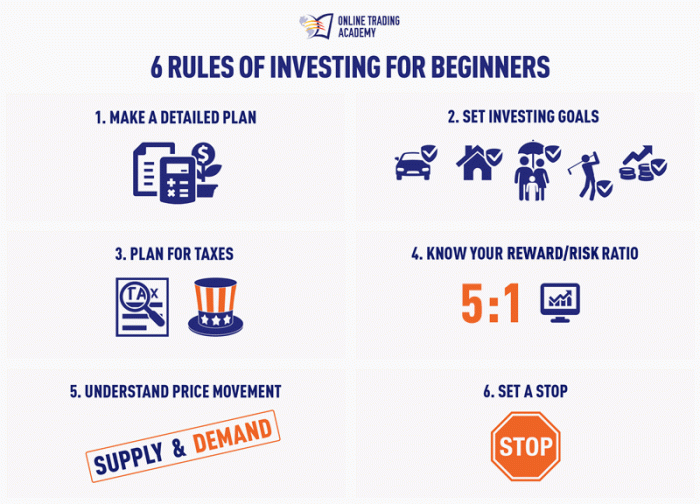Investing for Beginners dives into the world of finance, offering insights and tips for those new to the game. From understanding the basics to creating a solid investment plan, this guide has you covered.
Ready to take control of your financial future? Let’s explore the essentials of investing together.
Importance of Investing: Investing For Beginners
Investing is crucial for beginners as it provides a pathway to grow wealth over time and achieve financial goals. By putting money into various assets like stocks, bonds, real estate, or mutual funds, individuals can potentially earn higher returns compared to traditional savings accounts.
Combatting Inflation
Investing plays a vital role in combating inflation, which erodes the purchasing power of money over time. While savings accounts offer minimal interest rates that may not keep up with inflation, investing in assets with higher potential returns can help individuals stay ahead of inflation and preserve the value of their money.
- Stocks historically provide an average annual return of around 7% to 10%, outpacing inflation rates.
- Bonds and real estate investments also offer opportunities to earn higher returns than savings accounts, helping investors maintain their purchasing power.
Types of Investments

Investing for beginners can seem overwhelming, but understanding the different types of investments can help you make informed choices. Here are some common investment options suitable for beginners:
Stocks
Investing in stocks means buying shares of ownership in a company. Stocks can offer high potential returns but also come with high risks. Prices can fluctuate based on market conditions and company performance.
Bonds
Bonds are debt securities issued by companies or governments. When you buy a bond, you are essentially lending money to the issuer in exchange for periodic interest payments. Bonds are generally considered lower risk compared to stocks but offer lower returns.
Mutual Funds
Mutual funds pool money from multiple investors to invest in a diversified portfolio of stocks, bonds, or other securities. This diversity helps reduce risk compared to investing in individual stocks or bonds. Mutual funds are managed by professional fund managers who make investment decisions on behalf of investors.
Diversification for Risk Reduction
Diversification involves spreading your investments across different asset classes, industries, and geographic regions to reduce risk. By diversifying your portfolio, you can minimize the impact of a single investment performing poorly. For example, if one stock in your portfolio declines, the impact can be offset by the performance of other investments.Diversification is a key strategy to manage risk and maximize returns in your investment portfolio.
As a beginner investor, it’s essential to understand the different types of investments available and how diversification can help you achieve your financial goals.
Setting Investment Goals

Setting clear investment goals is crucial for beginners as it provides direction and helps in making informed decisions. It allows investors to focus on what they want to achieve and develop a plan to reach those objectives.
Tips for Defining Achievable Investment Objectives
- Start by assessing your financial situation and determining how much you can comfortably invest.
- Consider your investment timeline and whether you are looking for short-term or long-term returns.
- Define your risk tolerance level to understand how much volatility you can handle in your investments.
- Set specific, measurable, achievable, relevant, and time-bound (SMART) goals to track your progress effectively.
Role of Risk Tolerance in Determining Investment Goals
Your risk tolerance plays a significant role in shaping your investment goals. It determines the level of risk you are willing to take on in pursuit of higher returns. Understanding your risk tolerance helps in selecting investments that align with your comfort level and financial objectives.
Investment Strategies for Beginners
Investing can seem overwhelming, especially for beginners. However, with the right strategies in place, you can start building your wealth steadily. Here are some simple investment strategies suitable for beginners:
Creating an Investment Plan, Investing for Beginners
When starting your investment journey, the first step is to create a solid investment plan. This plan should Artikel your financial goals, risk tolerance, and time horizon. Here is a step-by-step guidance on creating an investment plan:
- Evaluate your current financial situation and determine your investment goals.
- Understand your risk tolerance and choose investments that align with your comfort level.
- Diversify your portfolio to reduce risk by investing in a mix of assets such as stocks, bonds, and mutual funds.
- Set a budget for investing and regularly contribute to your investment accounts.
- Monitor your investments regularly and make adjustments as needed to stay on track with your goals.
Regular Reviews and Adjustments
Regularly reviewing and adjusting your investment strategies is crucial for long-term success. Market conditions change, and your financial goals may evolve over time. Therefore, it’s essential to:
- Review your investment portfolio at least annually to ensure it still aligns with your goals and risk tolerance.
- Consider rebalancing your portfolio by selling overperforming assets and buying underperforming ones to maintain your desired asset allocation.
- Stay informed about market trends and economic developments that may impact your investments.
- Consult with a financial advisor if you’re unsure about making changes to your investment plan.
